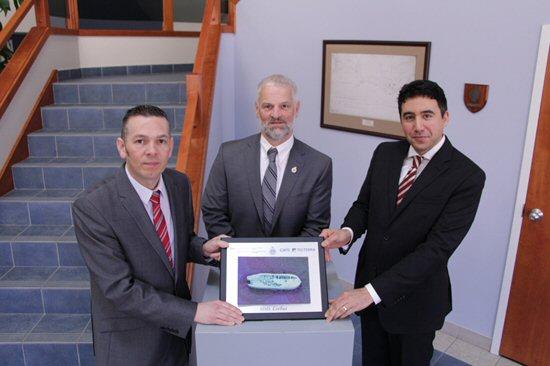Last December we reported on the 3D printing connection to a major find by an archaeological team funded and directed by the Canadian government: Two ships forming a small but important exploration fleet commanded by Rear Admiral Sir John Franklin were located after having gone missing for over 150 years. Franklin had been commissioned in 1845 by the Canadian government to locate the Northwest Passage but the expedition ended in tragedy and mystery, as the ships, the HMS Terror and the HMS Erebus, went missing. The HMS Erebus was not located until September 2014; the HMS Terror remains lost.

One of the ships of Sir John Franklin’s last expedition (Erebus or Terror), Date 1845, Illustrated London News
Following this major archaeological find, a 3D printed replica of the brass bell from the HMS Erebus was produced and became the central attraction of an exhibition sponsored by the Canadian government and the Royal Ontario Museum in Toronto.
Now the ships have become part of a new, extensive, collaborative 3D printing effort. Fisheries and Oceans Canada (FOC) teamed with the Canadian geospatial software company CARIS and the geomatics technology innovation support center TECTERRA to create high-precision 3D printed models of the HMS Erebus.
The modern-day search for the ships began in earnest in 2008 as part of a campaign on the part of the Canadian government to assert sovereignty over the recently opened Northwest Passage, now accessible because of ice melting in the Arctic. The search was successful when it was learned that Inuit elders in the area near King William Island had known of the ship’s location there for many years and were able to point researchers in the right direction.
Piecing together details of the expedition later, searchers and historians determined that the ships, which had been headed to Greenland, misjudged their location, were delayed, and then forced to backtrack. They were forced to spend the winter on Beechy Island in the Canadian Arctic Archipelago of Nunavut, Canada in the Wellington Channel moored to an iceberg and running low on provisions. Setting out again, the ships continued their voyage until September 1846, when they evidently became trapped in ice off of King William Island. They were never freed from the ice and a note found on the island later indicated that Sir John Franklin died there in June 1847 and his crew eventually perished as well. Searches by American and British ships never found the ships, at least not until the discovery of the HMS Erebus last fall.
The models of the HMS Erebus were created using multibeam sonar data that was collected by FOC’s Canadian Hydrographic Service. Bathymetric measurements were processed in seafloor mapping software that was created by New Brunswick-based CARIS and the 3D printed models were created by Calgary-based TECTERRA.
“It is a great honour to see Fredericton-based CARIS being part of the next steps of the discovery of one of the Franklin Expedition lost ships, HMS Erebus,” said the Honourable Keith Ashfield, Member of Parliament for Fredericton. “The model created here in New Brunswick by an innovative company will play a major role in the ongoing efforts to explore, research and understand one of Canada’s greatest mysteries.”
The scale models of HMS Erebus reflect the ship in its current, decayed state on the seafloor. The models are so intricately detailed that they provide a clear representation of the Erebus’ current state as well as materials on the seafloor surrounding the wrecked vessel, including the port side anchor.
Among other major benefits of having these accurate, detailed models is their critical role in preparing Parks Canada archaeologists and the Royal Canadian Navy’s divers for major dive operations into the wreck site this coming April. The upcoming exploration has been titled “Operation Nunalivut 2015.”
The effort is being lauded as an important moment for Canada in terms of its advanced technological capacity.
“Canada is a recognized global leader in the field of geomatics,” Dr. Salem Masry, CEO and President of CARIS, remarked on the subject. “It’s an honour to see Canadian software used to map this significant and historical shipwreck, and the added element of 3D printing provides an innovative means of transforming a scientific dataset into a product that a much broader audience can directly appreciate.”
This 3D printed model will be at the Ocean Business conference in Southampton, UK. The HMS Erebus will be on display the 14th-16th of this month.
What do you think of this historical preservation initiative? Join the discussion in the 3D Printed HMS Erebus forum thread over at 3DPB.com.
Subscribe to Our Email Newsletter
Stay up-to-date on all the latest news from the 3D printing industry and receive information and offers from third party vendors.
Print Services
Upload your 3D Models and get them printed quickly and efficiently.
You May Also Like
Consolidation in AM: How 2025 Is Shaping the Industry’s New Normal
The first half of 2025 has been marked by a clear shift in the additive manufacturing (AM) industry. Companies are no longer just focused on developing new tech by themselves....
Etsy Design Rule Change Reduces Selection of 3D Printed Goods
Online marketplace Etsy has implemented a rule change requiring all 3D printed goods on the site to be original designs. The update to the site’s Creativity Standards states, ¨Items produced using...
U.S. Congress Calls Out 3D Printing in Proposal for Commercial Reserve Manufacturing Network
Last week, the U.S. House of Representatives’ Appropriations Committee moved the FY 2026 defense bill forward to the House floor. Included in the legislation is a $131 million proposal for...
Transforming From Tourist to Native: Duro CEO Michael Corr Explains Why the Company Rebuilt its PLM Software on AI
In these early innings of the AI boom, many market analysts have expressed concern that AI spend has gotten too far ahead of the technology’s proven ability to deliver significant...


































